A genre of traditional Korean folk performing arts, the crane dance (hakchum) expresses the solemn dignity of Confucian scholars of the Joseon period by simulating the movements of a crane. With no literary sources available on its origin, the dance presumably evolved from other forms of folk dance. “Dongnae Crane Dance,” designated as Intangible Cultural Property No. 3 by the city of Busan, is characterized by improvisation.
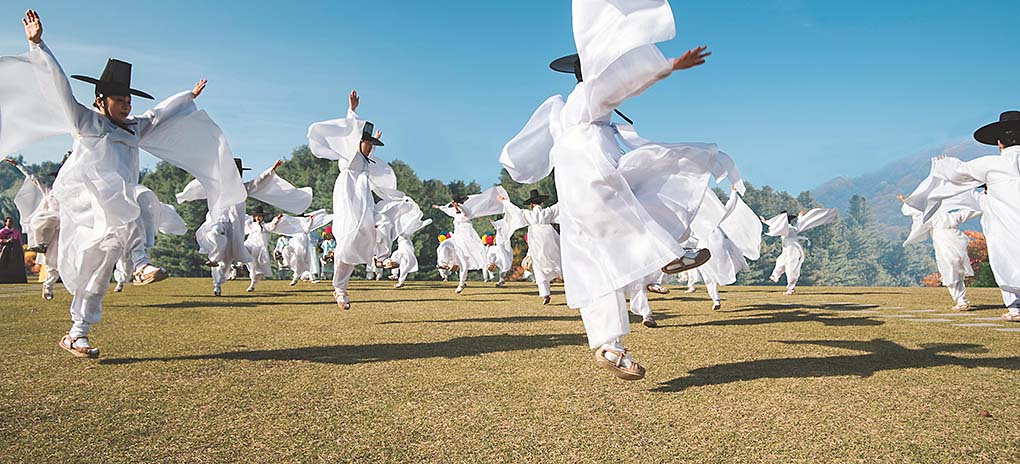
“Dongnae Crane Dance,” performed in a group of at least three to dozens at most, represents the lofty spirit and ideals of Confucian scholars, symbolically expressed through mimicry of a crane’s movements.
Courtesy of Lee Seong-hun
Dongnae is just another administrative district of Busan today, but back in the Joseon Dynasty (1392–1910) it was a major regional center and a hub of arts and culture. The training institute for professional female entertainers (gisaeng), located adjacent to the local government office, was frequented by wealthy patrons of the arts, and its famous natural hot springs attracted seekers of leisure and entertainment.
“Dongnae Yaryu,” a local version of masked dance drama performed around the first full moon day of the lunar year, featured a variety of dancers. Local legend has it that one day, a man dressed as a nobleman (yangban) appeared and danced elegantly. The audience was instantly mesmerized by his graceful movements, which they thought resembled a crane dancing. The moment marked the birth of the “Dongnae Crane Dance.”
So said Lee Seong-hun, a “living cultural treasure” designated by the city of Busan in recognition of his peerless expertise in the dance, about its origin. But this also might be just a fragment of the whole picture.
“It is a folk dance. The details of its origin have never been formally documented, so it can only be conjectured relying on the memories of local elders,” Lee said. “Where intangible cultural heritage is concerned, there is no such concept as ‘the original form.’ Countless variations and alterations are inevitable. As ‘Dongnae Yaryu’ was banned during the Japanese colonial period in an attempt to annihilate our culture, the dance performed before that time was probably a different version.”
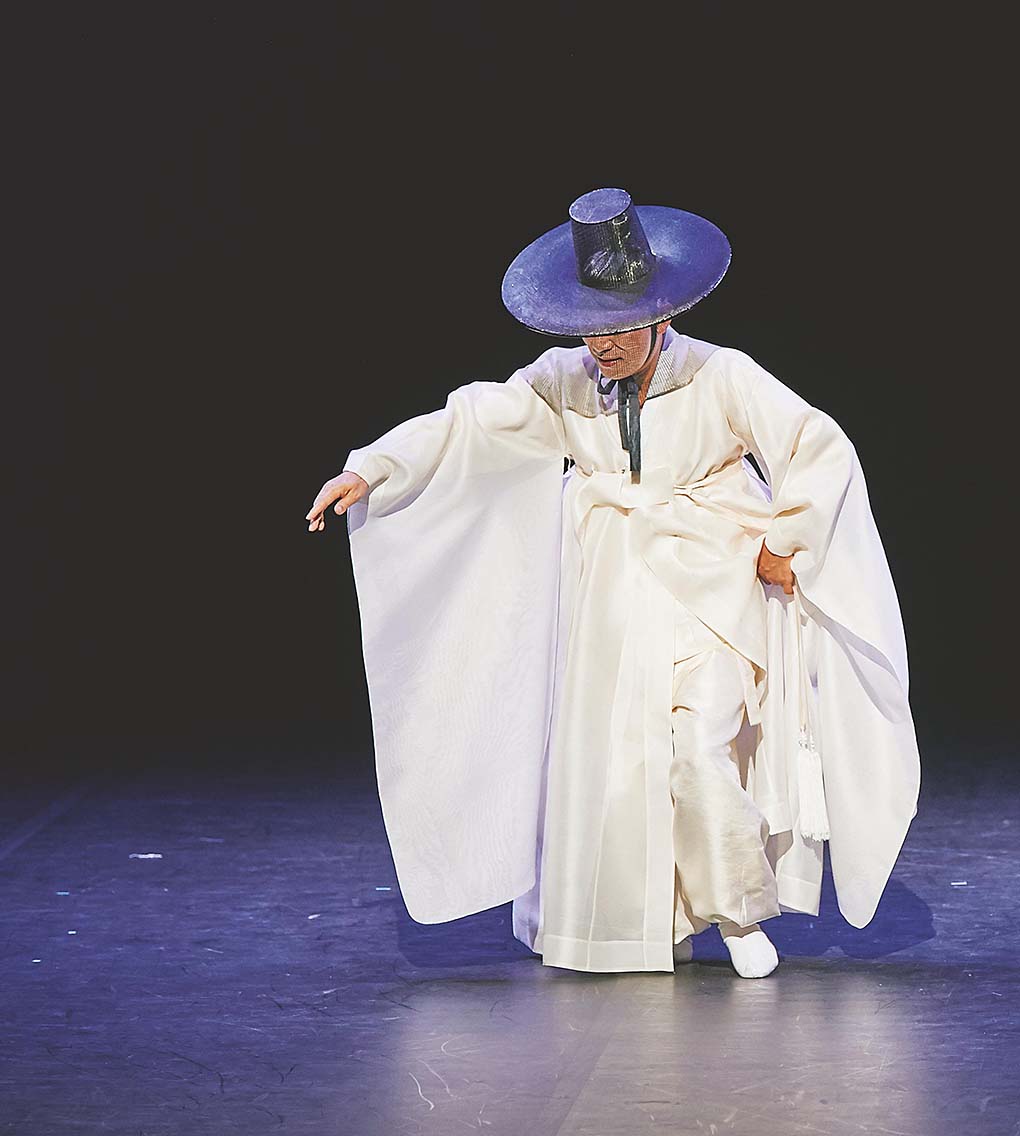
Lee Seong-hun believes the charm of “Dongnae Crane Dance” comes from the impromptu components inserted between set movements. © Korea Cultural Heritage Foundation
“Although not a tall or large man,
Mr. Lee dominates the stage while dancing.
It’s as if he carries a crane inside him.”
Spirit of the Confucian Scholar
Regardless of the dance’s debatable origin, the current form is similar to the folk mask dance of the Gyeongsang district in southeastern Korea, but modified with the mimicry of a crane’s movements. What is intriguing is that although it was, and still is, elegantly performed by dancers dressed in the Confucian scholar’s simple but dignified outfit, the dancers have never actually been scholars.
“Joseon’s scholars never danced as they were supposed to devote themselves to their studies. In other words, they considered themselves too dignified to dance,” Lee said. “Still, the crane dance has been known to embody their spirit, probably because the lofty character of a Confucian scholar was associated with the crane’s noble presence.”
Previously a solo dance, the crane dance is nowadays often performed in a group of at least three or even dozens at the most. The dance basically consists of 13 different movements and in its entirety lasts around 14 minutes and 30 seconds. For Lee, the quintessential movement is baegim sawi (bobbing in place), in which the dancer takes a long step forward and bobs up and down with the knees bent. Two other notable movements are the depictions of the crane taking flight, for which the dancer runs with his arms outstretched, with the wide sleeves of his robe flowing behind; and of the bird looking around searching for food, with the dancer raising his arms and then lowering them at the small of the back, bending forward at the waist and craning his neck from side to side.
Despite their seeming simplicity, these movements require a degree of proficiency to execute properly. “Ballet dancers stand on their toes and in most traditional Korean dances performers land with their heels, but in the crane dance you tread the ground with the entire sole of your foot. You need to create an air of elation with the bending and straightening of your legs, imitating a crane strutting on the snow,” Lee said.
The most difficult part of the dance is the breathing. Lee explained that, if the intensity of breathing is measured on a scale from one to ten, other traditional dances like seungmu (monk’s dance) or salpuri (dance to expel evil spirits) gently move between levels four and seven, while the crane dance has more ups and downs, falling to two and then suddenly soaring to eight.
Another characteristic feature are the impromptu components inserted between prescribed movements as individual dancers improvise in a free but orderly manner, considering the condition of the stage and the number of dancers in the group.
“I’d rather call it ‘improvisation’ than ‘free dance.’ Similar as the two terms might be, I believe proper naming affects the dancer’s attitude,” Lee said. “Improvisation enhances the quality of ‘Dongnae Crane Dance’ as a combination of artistic and natural movements.”
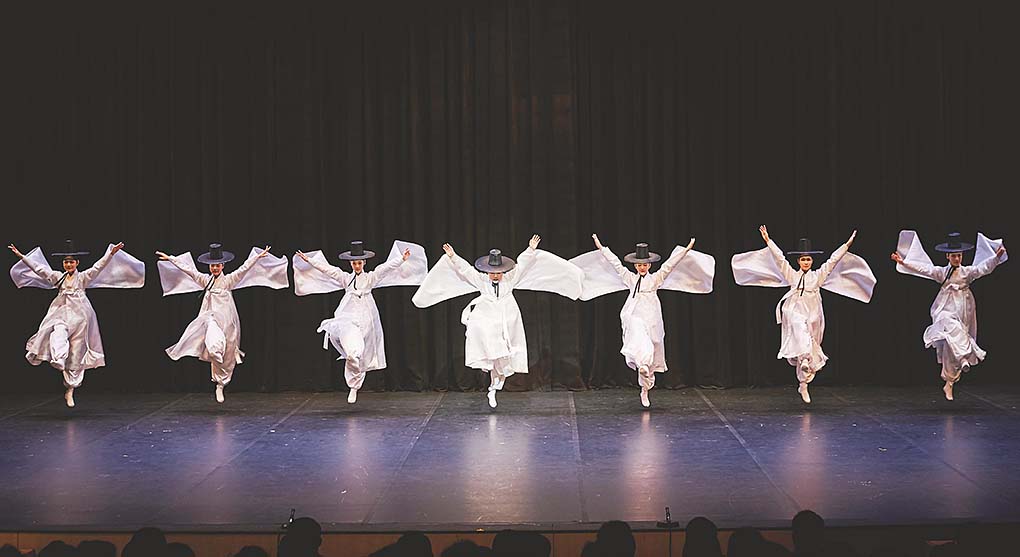
Lee Seong-hun, center, leads a group of dancers performing “Dongnae Crane Dance“ at the Osan Culture and Arts Center on September 6, 2019, as part of an event entitled “Shall We Pungnyu?” (Pungnyu refers to “enjoyment of refined arts”). © Korea Cultural Heritage Foundation
Unique Accompaniment
The crane dance is accompanied by a typical ensemble of percussion instruments, including the kkwaenggwari (small gong), jing (large gong), janggu (double-headed, hourglass-shaped drum) and buk (barrel drum). Especially added to this dance is humming (gu-eum), that is, the human voice. The humming is a mixture of the mimicry of instruments like the gayageum (twelve-stringed zither), ajaeng (seven-stringed zither), or haegeum (two-stringed fiddle); the mimicry of natural sounds; as well as melodic humming and interjections.
Lee attunes his dance to the humming, not to the kkwaenggwari that provides rhythmic structure to the dance. “The human voice expresses emotions, so it’s easier for me to lose myself in the dance with good humming. The percussion instruments support the human voice, which also softens any sound that falls out of harmony with the other instruments,” he said.
The vocalist does not utter any words with meaning or structure but hums melodiously or makes guttural sounds that support the dance movements or fill the voids between them. It cannot be done by just any singer. Lee’s long-time collaborator is Kim Sin-yeong.
Singing was a mere pastime for Kim when she met her teacher, and she had no knowledge whatsoever of humming. “My teacher’s voice was quite different from anything I’d heard before, inexplicably delightful and moving,” said Kim. However, she could not have formal lessons from her teacher, but instead used every opportunity to listen to her hum or sing songs in public performances. She recollected, “I had to get accustomed to every regional variety of traditional songs, including those of the northwestern provinces (seodo sori), southern provinces (namdo sori) and the central province of Gyeonggi, to discover what I could do best. As I grew more experienced, I could identify the style of humming suitable for each of the various dance genres.”
The impromptu nature of humming makes it more of a skill that is acquired by intuition rather than learned through formal training. It is not like performing pansori (narrative song) or other folk songs because the dance has no story line, so the singer has to look to the dance itself to find inspiration for improvisation.
“While humming for dance, you might or might not feel that you can see through the dance, depending on how well you know it,” Kim said. “I feel at ease when singing for Mr. Lee. We’ve been collaborating for so long that I have a clear idea of his dancing style, of how I can match my music with every detail of his movements. It’s not been long since I reached this stage. There are other dancers who are excellent but with whom I find it hard to collaborate. In that case I can’t sing the way I want to.”
After listening attentively to Kim, Lee said with a firm voice, “After mastering all forms of singing, the singer must finally try to convey all human joys and sorrows in her voice. The sound lying within from the days of hardship, the days of happiness and the days of pain should rise to the throat and spill over. Since her sound reflects her life, the singer should also discipline herself with rigorous self-reflection, and in the process build up the identity of her sound.”
This may also be what Lee has said to himself repeatedly over the last 30 years, whenever he tried to draw dance from within his body. His dance must have been forged by all the moments of his life: the day he was thrown out of his home as a 15-year-old boy because of his longing to become a dancer; the 10 years of his youth living at a dancing institute while enduring the cold treatment of others; the time he turned from modern to traditional dance after suffering from muscular injuries; and the moment he discovered the crane dance while learning the various folk performing arts of his hometown area.
Kim responded to his advice with a nod of understanding. “A true singer, my teacher said, does not sing with the mouth only, but with the entire body and mind. You should cry a lot and study a lot to have the universe infused in your songs.”
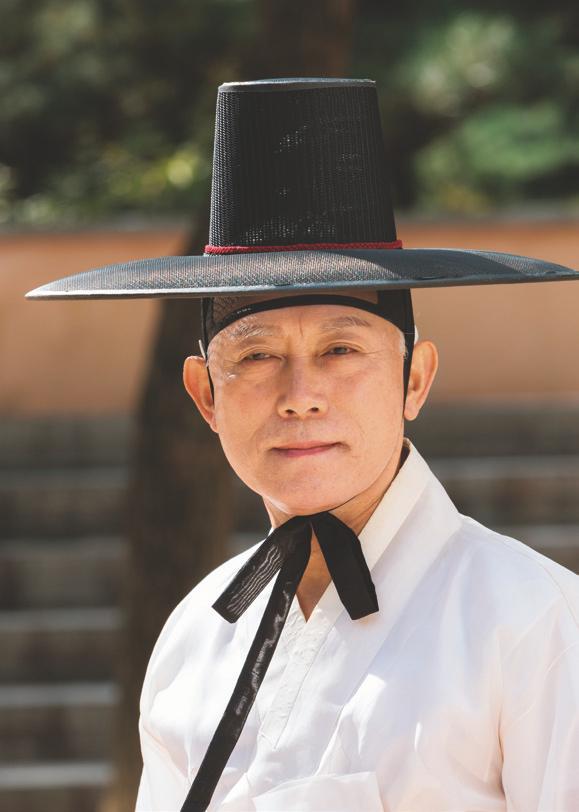
Lee left home at 15 and pursued his studies in dance while living at a dancing institute. He started to perform ”Dongnae Crane Dance“ as a member of the Busan Municipal Dance Company in the early 1980s. In 2016, he was designated as a cultural heritage title holder for his performance of the dance. © Ahn Hong-beom
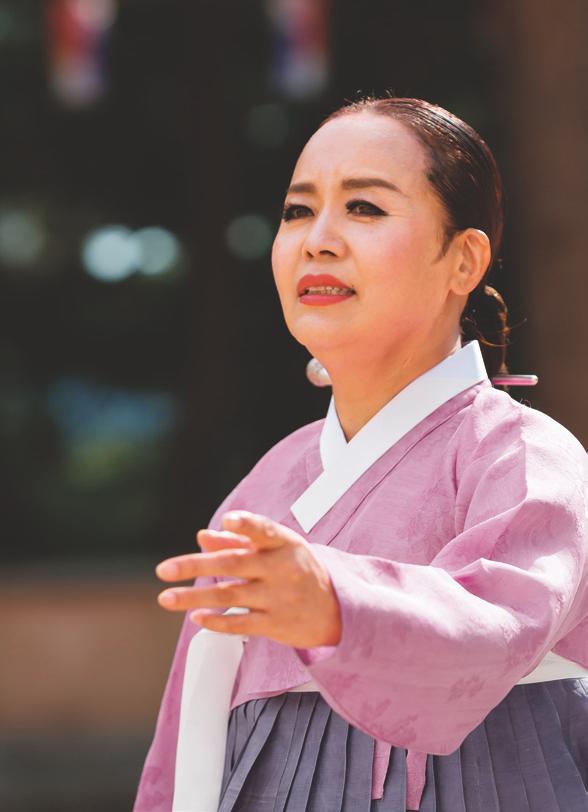
Kim Sin-yeong, a humming vocalist for the crane dance, endeavors to create her own sound, surpassing that of her late teacher Yu Geum-seon. © Ahn Hong-beom
Envisioning a Beautiful World
Now, the dancer and the singer who have performed together for so long commented on each other’s art. “Although not a tall or large man, Mr. Lee dominates the stage while dancing. It’s as if he carries a crane inside him. I think his dancing is nearing perfection,” Kim said.
In his turn, Lee said, “The singer must also know the dancer’s character, and Kim Sin-yeong can cope with my fastidious character so well that I feel comfortable dancing to her humming. But she needs to leave her teacher behind. Even if she maintains the feel of her teacher, she needs to be bold enough to create her own sound.”
When asked about their individual work, Lee was more at peace. Lee said that he creates his own fantasy world the moment he stands on stage and hears the music start, envisioning himself roaming the Daoist paradise, and that in his world he is trying and improving each year.
On the contrary, the singer, who obviously thinks she has not yet reached the depth of her sound, gave a reply as modest as the way she was sitting next to the dancer. A humming singer plays a supporting role in the crane dance, Kim said, so she needs to follow the dancing and be absorbed in it. She hoped one day to reach the state of total commune with the dancer on the stage.
Despite the apparent differences in their replies, the two artists were certainly of one mind as they envisioned a scene with a thousand people performing the crane dance together at Gwanghwamun Square in the heart of Seoul. As the crowd moves with the dignity of a noble-minded scholar, their long white robes fluttering in the wind, and the humming sound resonates through heaven and earth, the world will become a more beautiful place — at least as much as the two artists try to make it so with their dancing and singing.